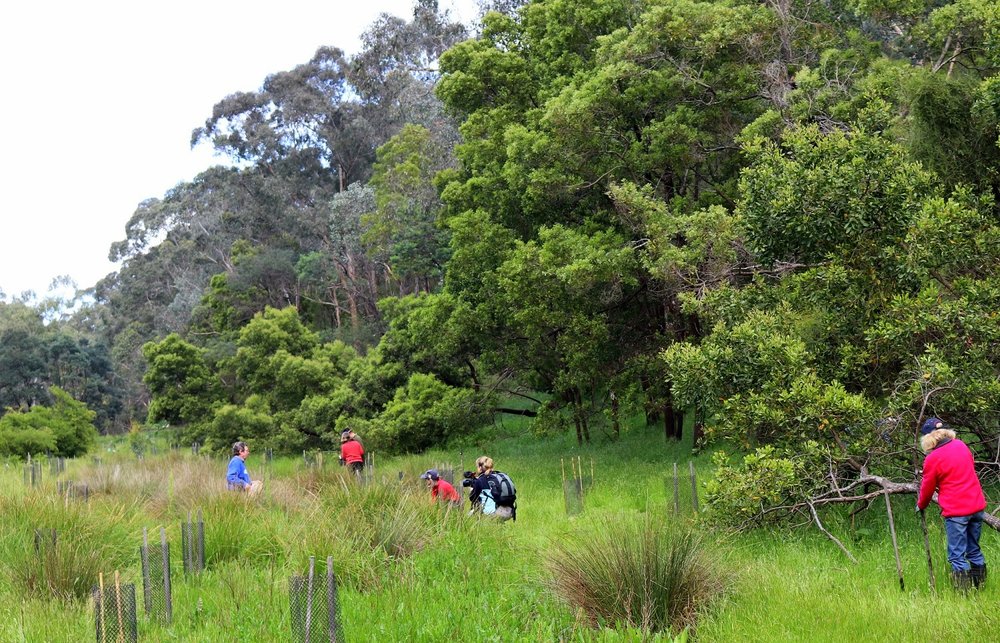There’s nothing more Australian than having to shake your gumboots upside down in case a redback spider (Latrodectus hasseltii) has decided to call them home. You’re never 100% sure (really, who wants to stick a bare hand down to find out?) but after a good few slaps of the undersole and a couple of vigorous shakes, I was at least 95% confident and slipped my foot in. Fully kitted up – gloves, boots and all – I was ready and welcomed into the Friends of Warrandyte State Park (FOWSP) fold as we headed down to plant eucalypts along the banks of the Yarra.
FOWSP is one of Victoria’s largest and most active Friends groups, with approximately 294 volunteer families operating out of a not-for-profit nursery since 1982. Located at Pound Bend, the nursery is beautifully nestled amongst gumtrees and wattles, and is gently enveloped by the flow of the Yarra. The nursery isn’t one in the conventional sense, at least not in the way I’ve thought of them since I was a kid. Whenever I visited a nursery with my green-thumbed father, it was English box hedges this and roses that. There was never a native lily (Bulbine bulbosa) in sight! Instead, at FOWSP you’ll discover a plethora of indigenous species in all their flowering glory (plenty of bulbine lilies, I might add!) owing to the nursery’s mission of cultivating and conserving indigenous plants of Warrandyte State Park and the Warrandyte-Kinglake Conservation Reserve.

The success of the FOWSP is undoubtedly due to the passion and dedication of its volunteers, some of which have been lending a helping hand for the better part of 20 years! Quite literally, come hail or shine, volunteers make their ritual journey to the nursery every Thursday. This is truly impressive, especially when you consider that some volunteers are in excess of 80 years young! When I asked what drew them here week after week and for so many years, the answer was both astonishingly simple yet profound: ‘It makes us feel good.’ Whether one was writing plant tags, weeding, cleaning or pruning, there was always time for chit-chat, playful banter, a passing smile or a welcoming wave from across the field. There was no pressure to stay or leave and everyone’s enthusiasm was infectious. It was the social aspect, the sense of family that made people ‘feel good’.
The mental and physical health benefits of gardening are well-known, ranging from improved cardiac function, warding off Alzheimer’s and improving self-esteem. Although levels of physical activity varied across the FOWSP volunteers, many thoroughly enjoyed the light mental stimulation of learning new horticultural techniques and the identification of indigenous plant species. One volunteer quite eloquently stated that ‘…unlike roses, indigenous plants teach you about the subtle beauty of plants and the landscape, they’re not as obvious as roses are.’ She went on to explain that it was because of this ‘awareness of subtlety’ that on one particular day walking through the State Park, she suddenly experienced ‘…sheer joy’.
A particular story that stuck out for me was that of a young woman in her late 30s who was very active all her life until she was suddenly struck down by a hip injury. Needing a hip replacement, she was not able to move for a considerable period of time and in the early stages of recovery, was house-bound – for her, essentially a prison sentence. But, just as any flower can break through stone, FOWSP extended a helping hand and soon she had broken free from her ‘prison’ and blossomed as the nursery became part of her mental and physical rehabilitation.

It soon became apparent to me that, in the most beautiful sense of irony, the nursery was in fact nursing people and not just plants. The enthusiastic and energised atmosphere coupled with the therapeutic act of gardening was providing feelings of wellbeing that lingered well into the week, permeating each person’s daily life.

FOWSP’s collective efforts, knowledge and experience have seen them develop many fruitful relationships, particularly with Parks Victoria. The combined use of resources, expertise and labour allows conservation efforts to extend well beyond the nursery’s gates and its immediate surrounds. In conjunction with Parks Victoria, FOWSP plays an important role in cultivating Victorian rare or threatened (VROT) plant species. Their success includes the re-discovery of locally extinct, indigenous plants like the leek lily (Bulbine semibarbata) and perhaps more poignantly, the revegetation of the Kinglake and St Andrews areas lost to the Black Saturday bushfires.
The morning was drawing to a close and we had just about planted the last of the saplings along the river’s banks. I stopped for just a moment. Drawing in a soft, deep breath of the cold, fresh air, I slowly and attentively worked the dark clay soil between my fingers and within my palms. Instinctively, I focused on how it felt – cold and moist, granulated yet smooth. I looked up slowly at the towering gums filtering the sun’s rays and then back at my hands where I cradled the sapling. I felt connected to the land in both time and space. An entire history was about to be written by people and animals who would enjoy the tree’s shade long after I would be gone.
Banner image is of revegetation along the Yarra River and is courtesy of Leonardo Guida.


Leave a Reply